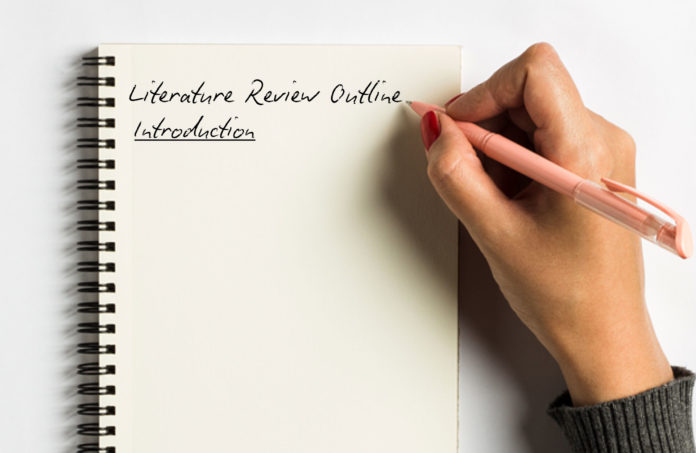Literature review refers to the survey of scholarly sources such as books, journal articles, and theses to give an overview of key findings, development, and concepts about a study problem. A literature review can be just a short summary of sources though it often has an organizational pattern and combines both summary and synthesis.
A literature review summary can be an outline of vital information of the sources while synthesis refers to the re-shuffling or re-organization of that information. A literature review outline aims at giving a new interpretation of old materials or brings together old and new interpretations of these materials. Besides, it may opt to trace the intellectual advancement of a particular field by citing major debates or influenced by the situation, a literature review can evaluate and advise the reader on the most relevant information regarding a research problem.
On this page:
How Literature Review Outline is Different from Academic Research Paper
An academic research paper aims to develop an argument and it is likely to have a literature review as one of its main parts. The literature review in an academic research paper forms a foundation and offers support for a new insight that you intend to bring forward. Nonetheless, the main focus of a literature review in an academic research paper is to summarize and synthesize the arguments and ideas of other scholars minus adding any new information.
Is it Important to Write Literature Reviews?
Literature reviews are essential as they provide you with a guide on the topic you are researching. If you are time-constrained on conducting research, a literature review comes in handy to give you an overview or act as a foundation for your research question. As a scholar, a well-written literature review outline will emphasize your credibility in your field besides providing a solid background for the research paper question you are researching. As such, comprehensive knowledge of the literature review in your research problem is vital for most research papers.
Things to Keep in Mind before Writing a Literature Review Outline
- Clarity
If you have been assigned a research question that is not specific, consider seeking clarification from your instructor. For instance, you should inquire about:
- Number of sources you should include
- Types of sources i.e books, journals, websites e.t.c
- Whether to summarize, critique or synthesis your sources by discussing a common issue
- Whether to evaluate your sources
- Whether you will provide sub-heading or any other background information like definition or history.
- Look for Examples
Find other literature reviews in your area of study and read them to get valuable information and ideas you might want to consider looking for in your upcoming research or ways to organize your literature review outline. You can find great examples if you search online in any electronic database. The reference section, of course, you already have with you is an excellent entry point for your research question.
- Narrowing of your Topic
There are numerous books and articles on various areas of study. However, the narrow your topic is the easier it will be for you to limit the number and type of sources you need to read to come up with a great survey material. Certainly, your instructor won’t expect you to read all the sources you find in your research question. But the more you narrow your research question, you will find an easy way to read more sources specific to your scope.
- Consider whether your Sources are Current
Some disciplines require students to use the most current information. For instance, the medical field is constantly changing. Information of even two to three years can be obsolete. But if you are researching in the field of humanities, social sciences, and history, a literature review may not be required since what matters in this field is how perspectives have changed through the years or within a limited period. So, consider getting the most current sources in your scope of the study to get an idea of what your discipline requires of you.
How to Write a Literature Review Outline
A literature review is usually built around ideas and this means that you will not just be listing your sources but going an extra mile into the details about each source. You might be assigned a dissertation that requires you to conduct a literature review to place your research question within an existing knowledge. Also, you may be assigned to write a literature review as a stand-alone paper which will be slightly different in terms of content, but the procedure of writing a literature review for both cases will be guided by similar steps.
Step One: Collect, Evaluate and Select Literature
After narrowing your topic searching for literature becomes easier. If you are writing your literature review outline as a stand-alone paper, you will need to select a focus and build a central question that will direct your research. However, if your literature review is a section of a research paper, then the literature section will have to relate to your research question.
When searching for literature, search using specific keywords and citations from your research question. If you find a useful article, make sure you check the bibliography list to get more relevant sources. Read the abstracts of these sources to find out whether the information contained therein can be helpful. Evaluate which sources are most relevant and valuable to your research question by asking the following questions:
- What problem or issue is the writer addressing?
- What key concepts are therein and how are they defined?
- What key theories, methods, and models are therein? Is the research establishing frameworks or taking an innovative approach?
- What is the outcome and conclusion of the research?
- Is the publication related to other works of literature in the scope of the study?
- What are the strengths and weaknesses of the study?
To make a landmark in your field of study, make sure you use only credible sources.
As you read and collect your literature, make sure you are making a few notes here and there. These notes will help you keep track of your sources, especially during citation and in avoiding plagiarism.
Step Two: Establish Connections and Themes
Before you start writing your literature review in an organized manner, you must identify the relationship between the different sources you have collected and read. Guided by your reading and notes, look out for:
- Pattern and trends in theory, method or outcome
- Themes – what concepts or questions that recur across the literature
- Debates – contradiction and conflict, where does the source disagree?
- Gap – what information is missing from the literature that needs to be addressed?
- Pivotal publications – are there influential studies or theories that influence the direction of the scope of your study
Step Three: Plan the Organizational Structure of your Literature Review
A literature review outline takes different approaches when it comes to organizing its body. So, you should have an idea of what strategy you will use before you begin writing. The strategy you pick will be influenced by the length of your literature review. You can combine the following strategies when planning the overall structure of your literature review.
- Chronological
This is the simplest strategy of tracing the development of your literature review outline over time. Nonetheless, if you pick this plan, be careful to avoid just listing and making summaries of your sources in order. But be sure to analyze patterns, turning points, and main debates which shape the focus point of your scope of the study. Consider giving interpretations as to why and how particular developments occurred in the literature.
- Thematic
If you get some recurring central themes in your scope of the study, you can organize your literature review outline to subsections which address the specific aspects of the research question or problem.
- Methodological
If you intend to draw your sources from various disciplines or fields that utilize different research methods, you may want to compare the outcomes and conclusions that come from these different approaches. For instance:
- What outcomes emerge in qualitative versus quantitative research?
- Discuss how the problem has been tackled by empirical and theoretical scholarship
- Divide the literature into sections such as historical, sociological as well as cultural sources
- Theoretical
A literature review is usually the foundation for any theoretical framework. To come up with a great theoretical framework, you should use different theories, definitions or key concepts and models. You can argue for the application of a particular theoretical strategy or even amalgamate different theoretical concepts to come up with a framework for your study.
Step Four: Compose your Literature Review
Once you have settled for your ideal pattern of organization of your literature review outline, you can start putting its content in writing. Like other academic papers, a literature review should contain the following: Introduction, Main Body and Conclusion. What each section will contain will depend on the objective of the literature review.
- Introduction
This section is where you clearly outline what the literature review will focus on and what it intends to achieve. You can also state how the entire literature review will contain.
- Main Body
The main body can be divided into different sections depending on the length of the literature review. Each section can have a sub-heading for a theme it discusses, period or methodological approach.
In the course of writing the literature review’s main body, keep the following tips in mind:
- Summarize and Synthesis the main information by giving an overview of the key points of each source and then combine them in a coherent whole.
- Analyze and Interpret: You should not just paraphrase other scholars’ researchers but consider adding your interpretation where possible. Also, discuss the importance of the findings of your literature as a whole.
- Critical Value: Be sure to identify the strengths and weakness of the resources you are using.
- Structure your paragraphs well: consider using transition phrases and topic sentences to draw connections contrast and comparisons in your literature review.
Conclusion
The conclusion of your literature review should summarize the main findings in your literature review while emphasizing their importance.
Do the following When Writing a Literature Review
Use evidence: Make sure you use sources when arguing your point. Your discussion and interpretation of the available sources must be supported with solid evidence to show whatever you are saying is valid.
- Use Quotes Cautiously
The survey nature of literature reviews doesn’t allow in-depth discussion or even detailed quotes from texts. However, a short quote here and there isn’t bad at all. If you are emphasizing what the author is saying, consider rephrasing what they have written in your own words.
- Maintain your Voice
Even though literature reviews present other scholars’ ideas, keeping your voice should remain at the forefront. Start and end your paragraphs in your own words.
- Be Cautious when Paraphrasing
When it comes to paraphrasing a source that isn’t your own, make sure you accurately present information and opinions of the author in your own words.
- Revise
Never submit unrevised academic paper no matter how short its length is. Once you have completed writing your literature review, spending a long time revising is recommendable. Check your review and ascertain that it follows the required outline, clear any grammatical, spelling and sentence structure issues. Also, check whether you have the right quotations and that plagiarism is not neglected.
Writing a literature review requires a strong background in a specific field of study. As such, you should be able to identify up to date studies in your scope of the study. Before you start writing your literature review, make sure you have mastered the topic before moving to other scholars’ works in the same field. This is the key to successful literature review writing!

